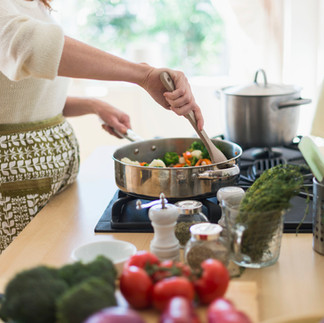Did you know that creating a meal plan and sticking to it at home will help you stay organized, less stressed, and save money. The same is true when helping prepare meals for clients. Creating a meal plan with your client will help everyone stay organized, it simplifies the task of preparing food, and makes grocery shopping for your client much easier. It also helps ensure your client is receiving the optimal amount of nutrition.
If creating a meal plan and sticking to it sounds overwhelming, don't worry! We have some steps below that will help you come up with a plan with your client and/or their family members!
Keep it Simple! First things first, make sure you know of any diet restrictions or preferences your client may have. Ask for a list of 5-10 favorite meals, vegetables, lunch ideas, and breakfast ideas. Are there any favorite family recipes they would like to incorporate? Check out our Recipe page on our website for some basic and simple recipes that use basic ingredients that most clients should have available. This will help you create a "master list" of meals that you can rotate. Keep in mind if you are only visiting your client a few times a week but need to make meals for every day, you will need to plan for easy to reheat meal ideas or leftovers.
Food variety. Make sure your client has a variety of types of entrees and vegetables or side dishes. By mixing things up you will help make sure they are receiving a well-balanced diet that supplies nutrients from different kinds of foods. It also keeps things interesting by having a variety of flavors and textures, spices and cuisines.
Temperature. Ask your client how they prefer to receive their food. Do they like it piping hot, lukewarm, cold? Do they prefer ice in their drinks? Please note: Always make sure you are cooking food (especially meats) to the correct temperature to make sure it is safe to eat.
Budget. Does the client's budget allow for the types of foods necessary for the meal plan you created? Look through grocery store ads to see if there are any sales for foods the client likes to eat.
Use the pantry. Before making a trip to the grocery store, check the client's cupboards/pantry to see what is already available. (Ask for the client's permission before you begin opening all the cupboards!) Is there any produce that needs used up?
Rotate menus. Typically, it is best to do one weekly menu plan at a time. Activities and plans pop up, so check with your client if they have any scheduled appointments or plans.
Prioritize protein. Older adults need at least 0.5 to 0.6 grams of protein per pound of body weight; or at least 20 grams every time they eat. Food items high in protein that are easily prepared and consumed include: cottage cheese, ricotta cheese, nut butters, eggs, frozen meatballs, chopped chicken, tuna pouches, and baked tofu. These foods can easily be mixed with simple sides like rice, pasta, whole-grain bread and fruits and vegetables to create easy meals.
Read the labels. If you client has a special diet, read the labels. When helping clients choose foods for a low sodium or salt-free diet, you must read the product label to see if salt was used in preparing the food item. If they are on a restricted sugar diet, watch the labels for added sugar and the total sugar count that has been added. Educate yourself on what food labels mean to help you help your client.
If you are in a home where other caregivers are also coming in, post the menu plan in a spot where they can all see it, like on the refrigerator. Encourage feedback or ideas from others as well!
Remember, a poor appetite does not mean that the client's need for food is less. Medication, illness, or chronic diseases may cause a client to not want to eat. But the client needs as much food as ever to return to health. To make meals as enjoyable and appetizing as possible, consider the surroundings, sights and aromas of food. Make it fun by encouraging the client to be part of the preparation process, make the plate presentation enjoyable and pretty, or make something special if they request it. Mealtime is often one of the highlights of the day for a client and gives them something to look forward to. Don't be afraid to be creative! Figuring out what works for your client's mealtime will help them respond more positively and help them get the nutritious and fulfilling foods they need for optimal health. Go have fun and start cooking!
Source: Indiana Association for Home & Hospice Care







Comments